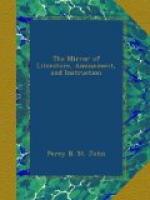ANTIQUITIES BURLESQUED.
We have often been amused with the different wonders of ancient Rome, but seldom more than with the following piece of antiquarianism burlesqued:—
M. Simond, in his Tour in Italy and Sicily, tells us that the Coliseum is too ruinous—that the Egyptian Museum in the Vatican puts him in mind of the five wigs in the barber Figaro’s shop-window—that the Apollo Belvidere looks like a broken-backed young gentleman shooting at a target for the amusement of young ladies. Speaking of the Etruscan vases, he says, “As to the alleged elegance of form, I should be inclined to appeal from the present to succeeding generations, when the transformation of every pitcher, milk-pot and butter-pan, into an antique shape, has completely burlesqued away the classical feeling, and restored impartiality to taste.”
* * * * *
About six or seven-and-twenty years ago, an effort was made to revive the fashion of ladies visiting the House of Commons. The late Queen Caroline, then Princess of Wales, upon one or two occasions made her appearance, with a female attendant, in the side-gallery. The royal visit soon became generally known, and several other females were tempted to follow the example. Among these was Mrs. Sheridan, the wife of the late Right Honourable Richard Brinsley Sheridan; but this lady, considering herself an intruder, to whose presence, if known, exception might be taken, thought fit to disguise her person in male attire. Her fine dark hair was combed smooth on her forehead, and made to sit close, in good puritanical trim, while a long, loose, brown coat concealed her feminine proportions. Thus prepared, she took her seat in the Strangers’ Gallery, anxious to witness a display of her husband’s eloquence; but he did not speak, and the debate proved without any interest. The female aspirants whose taste was thus excited, were, however, confined to a few blue-stocking belles, without influence to set the fashion; and the attempt did not succeed.
* * * * *
MOCHA.
The buildings of Mocha are so white, that it seems as if excavated from a quarry of marble; and this whiteness of the town forms a curious contrast with the blueness of the sea. The materials, however, of which Mocha is constructed, are nothing better than unburnt bricks, plastered over, and whitewashed. The coffee bean is cultivated in the interior, and is thence brought to Mocha for exportation. The Arabs themselves use the husks, which make but an inferior infusion. Vegetables are grown round the town, and fruits are brought from Senna; while grain, horses, asses, and sheep, are imported from Abyssinia. There are twelve schools in the town; and, inland, near Senna, there are colleges, in which the twelve branches of Mohomedan sciences are taught, as is usual in Turkey and India. Arab women marry about the age of sixteen; they are allowed great liberty in visiting one another, and can divorce their husbands on very slight grounds. Every lady who pays a visit, carries a small bag of coffee with her, which enables “her to enjoy society without putting her friends to expense.”—Lushington’s Journey from Calcutta to Europe.




